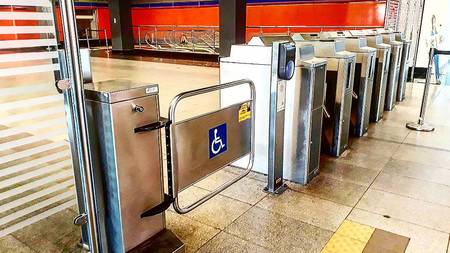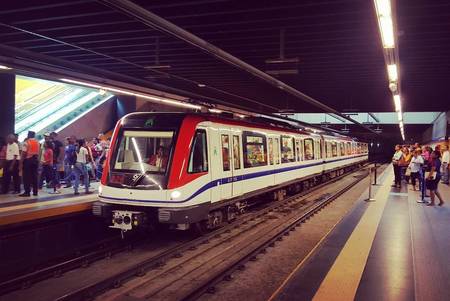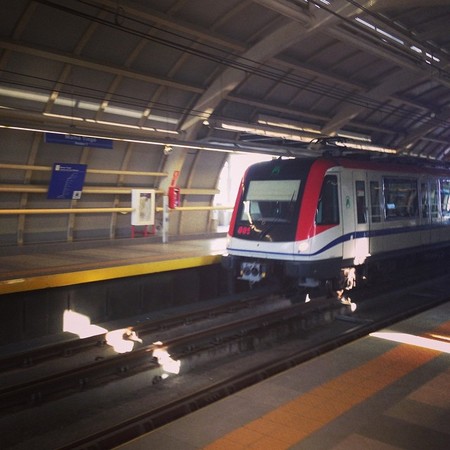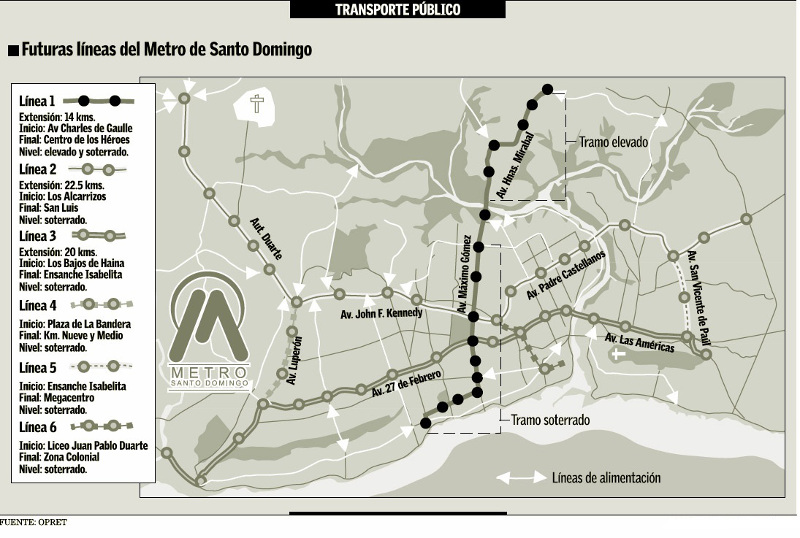The metro in Santo Domingo, in the Dominican Republic, is a new network (2008) which includes 2 operating lines and 30 stations with a total distance of about 50 kilometers. It operates every day of the week from 6:00 AM to 10:30 PM. The time between trains varies from 5 to 10 minutes. The price for a simple trip is RD$ 20, though to this cost is added the RD$ 15 cost of the card itself.
Metros in Dominican Republic: The Santo Domingo Metro
The City
Santo Domingo is the capital of the Dominican Republic, and is one of the most popular tourist destinations in the Caribbean, because of its joyful ambience and its colorful and majestic scenery.
Currently it is the cultural epicenter of the Dominican Republic, because it contains such a mix of diverse customs and traditions, making it a very culturally rich destination. In addition, it offers great financial, political and commercial contributions to the country, because in it are found the most important industries in the Dominican Republic. Additionally, because of the economic stability that the city generally offers, it has caught the attention of investors, businessmen and franchise owners. Its population is large and diverse, primarily made up of native Dominican mulattos, but a large part (more than 20%) is made up of immigrants; among them Asians (mostly Chinese), Arabs, Afro-Dominicans, European-Dominicans, Venezuelans and Puerto Ricans. At the time of the 2010 census, the city had a population of 3.8 million people.
The Metro
Santo Domingo’s metro is relatively new and is one of the biggest rail systems in Central America and the Caribbean. Interestingly, the project was thought of and proposed by the Brazilian president, Lula da Silva, to the then president of the Dominican Republic, Hipólito Mejía. At that time, the Dominican president didn’t accept the proposal, but a little later, in 2005, President Leonel Fernández decided to undertake the construction of the new system of transportation for the city.
More than 700 million dollars were invested in the project for the construction of what would become the first rail system, not only in Santo Domingo, but in the country as a whole. The Santo Domingo Metro was inaugurated February 27, 2008, with one operating line (Line 1) and 16 stations; the inauguration was attended by Dominican officials as well as technicians from Madrid’s metro, who had offered their services in consultancy and supervision.
 Santo Domingo Metro
Santo Domingo Metro
Lines and stations
The Santo Domingo Metro is currently made up of two operating lines and thirty stations; some of them elevated and some underground, reaching a total distance of 48.5 km, in which the trains travel at a speed of 80 km/h. The first line was unofficially inaugurated in 2008, covering the north-south route, while the second began to be operational in 2013, crossing the city from east to west.
Line 1
Line 1 is identified as the “Blue Line” in the Santo Domingo Metro. It is made up of 16 stations, in which the train picks up passengers from the north of the city to the south, reaching a length of 14.5 km.
This line was extremely necessary, since the traffic congestion in the area was very bad. The city’s inhabitants spent large amounts of time trying to travel, primarily, to the center of the capital, which caused a lot of trouble and inconvenience. With the construction of this mode of transportation there was a great decrease in traffic congestion in the area.
Another aspect of this line worth pointing out is that along its route are found many entertainment and recreational points of interest, like restaurants, which according to the locals are the best in the city; cafés, malls, museums, parks, hotels and theaters, among others.
Line 2
Line 2 of the Santo Domingo Metro is identified as the “Red Line.” It crosses the city from east to west, with a length of 34 km. This route covers many important avenues, like the Autopista Duarte, John Fitzgerald Kennedy Avenue, the Expreso V Centenario, and Padre Castellanos Avenue. It includes 14 passenger stations, which, like those in Line 1, are also surrounded by lots of businesses, sporting areas, hotels and other points which can be reached on foot with no problem.
Schedule and frequency of the trains
The Santo Domingo Metro operates every day of the week, because of the high passenger demand. The system tries to offer the best schedule possible in order to permit connections to other modes of transportation, both public and private. The designated hours of service are from 6:00 AM to 10:30 PM, Monday to Sunday. Depending on the line, and on which day of the week you decide to take the metro, the frequency of the trains can vary, however the estimated wait time is around 5-10 minutes (maximum).
Fares
The Santo Domingo Metro offers two methods of payment to travelers using its services. These are: the Santo Domingo Metro Single-charge Card and the Santo Domingo Metro Rechargeable Card.
Santo Domingo Metro Single-charge Card: As its name indicates, this card cannot be recharged; it can be bought at any ticket window at any metro station for RD$15 ($0.31 USD). Then it can be charged (only one time) with an amount which can vary depending on the travel option that you choose. If it is to be used for only one trip the price is RD$20 ($.042 USD), for a round trip it will need RD$40 ($0.83 USD), and for an all-day pass –that is, valid for 24 hours from the time it is registered in the first entrance- the price is RD$80 ($1.66 USD).
Santo Domingo Metro Rechargeable Card: Once you have this card it can be used on more than one occasion by recharging it with different amounts. It is a plastic card, not disposable, which like the other type of card can be used in any metro station. To buy the card itself the user pays RD$200 ($4.15 USD), which price includes the card (RD$60) and seven trips (RD$140). When the passenger wants to recharge for one trip, it costs RD$20 ($0.42 USD); for a round trip, twice that: RD$40 ($0.83 USD). If you want to recharge the card for 10 trips, it will cost RD$185 ($3.84 USD), and for 20 trips RD$360 ($7.48 USD).

Both cards can be acquired without any problem at any ticket window within the network of stations in the Santo Domingo Metro. However, there are certain deadlines for getting them and some requirements that the passenger has to fulfill (but nothing that requires a lot of paperwork). All of the information about it can be found right there in the stations.
Advice for using the metro
- There are certain recommendations that the user should keep in mind when entering the Santo Domingo Metro:
- Never go past the security line at the platform, you need to wait behind the line until the train has stopped.
- Let the unloading passengers get off the train before trying to enter, otherwise you could cause unnecessary delays.
- Once the alarm has sounded to signal that the doors will be closing, for your security do not enter or leave the train.
- Do not act in a way that will make the other passengers in the car uncomfortable.
- Do not travel with large items that could be dangerous.
- Do not smoke in the trains or in the other metro installations.
- Do not enter the train conductor’s cabin.
- Do not activate without proper cause the alarm mechanisms of the train cars, because this will cause unnecessary delays.
- Do not travel with animals, except for seeing-eye dogs.
- Follow the rules and instructions of the metro personnel.
Security
The Santo Domingo Metro has the support of a special body of police dedicated to its security. This body is named CESMET, and they are responsible to guard the security of the passengers and also maintain a permanent control of all the operations of the transportation system.
The security which the rail system offers guarantees its successful function, considering that it is one of the most-used means of transportation by the inhabitants of the Dominican Republic’s capital.
Connection with the Airport
The Santo Domingo Metro does not have a station that connects it directly to the International Airport Las Americas, the city’s main airport, since it is located 30 minutes outside the capital. However, using the metro, passengers can arrive at the station from which buses take people to the airport.
If you are coming from the north or south of the city, you can catch the train at any of the Line 1 stations, and go to the Pedro Livio Cedeño station. Once there, you can transfer to Line 2, to take the train towards the Horacio Vásquez station. In the area around the station you will find taxis which will take you to the airport in approximately 27 minutes (depending on the day’s traffic), in the Autopista Las Americas. You will need to take Calle Josefa Brea towards Calle Luis Reyes Acosta; a little farther along, in about 1.4 km you will come to a corner where you will need to turn towards the Juan Pablo Duarte Bridge, and continuing about 750 meters, you will need to turn again to the left to take Carretera 3. In the exit from this highway you will find the Las Americas International Airport.
If, on the other hand, you are coming from the western zone of the city, you can board the train at any of the Line 2 stations, and can get off the train at either the Ramón Cáceres station or the Horacio Vásquez station. At either of these two stations there are taxi companies that can take you to the airport.
Internal Connections
Santo Domingo Cable Car
The Eduardo Brito station in Line 2 of the Santo Domingo Metro is the closest station to the city’s cable car line. In fact, the necessary modifications are being made in order for there to be a direct connection between the two, so that passengers will not need to use any other mode of transportation to reach the Santo Domingo cable car line. If you go on foot from the metro station to the cable car station, it is at least a one hour walk (6.1 km) along Los Restauradores Avenue, mostly flat; some people choose this option as a way of getting exercise. If, on the other hand, you decide to take a taxi to reach the station, it will take the same route but will arrive in only 21 minutes (depending on the traffic).

Santo Domingo’s Sans Souci Terminal
The fastest route to get to the Sans Souci Terminal by the Santo Domingo Metro is to head north towards the Hermanas Mirabal station in Line 1. Once you are in route, you need to make sure to get off the train at the Profesor Juan Bosh station, where you will find a line of buses which head to the terminal. Otherwise, you can also take a taxi, and you will get there in around 30 minutes.
Future expansion projects
The design of the Santo Domingo Metro includes the construction of six rail lines. The company in charge of the project (OPRET) affirmed that the project –which is called the Master Plan for the Regulation of Transport in Santo Domingo- will be completed in three phases, from shorter to longer duration.
With this construction the project will attempt to organize and clear the main travel routes of the city, which means performing a broad study of all the routes in Santo Domingo and its municipalities, and diagraming the system’s principal arteries by way of underground routes heading from east to west and north to south.
The maximum period to complete this project is not more than 20 years, however, it is hoped that there will be important aspects realized within an estimated time of 3 years.
Expansion of Line 2
In 2015, plans were made for the expansion of Line 2 of the Santo Domingo Metro, which will cross the Ozama river by way of a railway bridge (parallel to the Francisco del Rosario Sánchez Bridge), with more than 1000 meters of length.
It will continue its course along the length of San Vincente de Paúl Avenue until it intercepts Carretera Mella, at around 3.25 km. Thanks to this expansion of Line 2, 4 more stations will be put in use for the service of the metro passengers.
The excavation work to construct the tunnel underneath San Vincente de Paúl Avenue began in March, 2014, and in April of the same year construction was started on the bridge over the Ozama River –which connects the National District with the eastern zone of the city.
The first trial runs of trains in the stations that make up the extension of Line 2 of the Santo Domingo Metro were planned for April of 2016. It is important to point out that approximately 385 million dollars were invested in this construction, of which 70 million were designated for the construction of the bridge over the Ozama River.
Line 3
Another planned improvement in the Santo Domingo Metro is the construction of a third line, which will begin in Los Abos de Haina, and will cross two of the city’s very important rivers: the Haina and the Ozama. Two large bridges will be built over these rivers, very similar to the one that crosses the Isabela River (heading towards Villa Mella).
The first station in the Santo Domingo Metro’s Line 3 will be located adjacent to the Haina port, while the last will be situated in the Isabelita region, to the east of the city. The route will encompass a distance of 20 km, and will include 21 stations.
According to what has been planned, this line will be constructed underneath Carrretera Sánchez, using excavated tunnels. It will cross Luperón Avenue, also known as the Plaza de la Bandera, and will also have access to the 27 de Febrero Avenue as far as the Ozama River. However, it will cross the Ozama River by means of a surface channel and will later go underground again, to end in Isabelita. Within this planning is included the connection of this line with lines 1 and 2 of the Santo Domingo Metro.
Places of interest to tourists
The Ciudad Colonial
The Ciudad Colonial, also known as the “Colonial Zone,” is one of the zones most visited by tourists because of its colorful atmosphere, full of history and recreational points of interest. This was the first area of Santo Domingo conquered by the era’s Spanish colonists, and is one of the places in the city that every tourist visits, because of its popularity as a recreational destination.
In the Ciudad Colonial, you can stroll pleasantly, visiting different colonial buildings along streets with ancient pavements, finding sites of great historical interest like the Alcazár de Colón and the Museo de las Casas Reales, among others. Because of its range of tourist interests, the colonial zone has many national and international hotels which offer a comfortable stay to the area’s visitors.
How do I get there on the Santo Domingo Metro?
You can catch the train at any of the Line 1 stations, and you will have three possible routes to access the Ciudad Colonial. The first route that you can take, and the fastest, is the Ensanche Kennedy route. You need to be alert to get off the train at the Kennedy station, and once outside, you can get a taxi, which will take you in less than 15 minutes to the Ciudad Colonial. The second route, also very easy to access (14 minutes from the nearest station) is along the 27 de Febrero Avenue. If you want to go this way, you will need to get off at the Profesor Juan Bosh station –also in Line 1, and take a taxi to your destination. The third route is by way of George Washington Avenue; using the Santo Domingo Metro’s Line 2, you need to travel until the Juan Ulises García Saleta station, and take a taxi from there which will take you along the whole George Washington Avenue –in not more than 15 minutes– to the colonial zone.
Museo del Hombre Dominicano
The Museo del Hombre Dominicano was inaugurated on October 12, 1973, during the presidency of Joaquín Balaguer. It is found in the Plaza de la Cultura, and is one of the city’s biggest attractions. Its facilities include diverse spaces for artistic expositions, in which are found antiques and artifacts of great cultural interest, greatly valued by the Caribbean people, especially the inhabitants of the island of Hispaniola. This place, of such interest to tourists, gives a broad view of the characteristics of the Dominican people.
How do I get there by the Santo Domingo Metro?
Reaching the Museo del Hombre Dominicano by way of the Santo Domingo Metro is extremely fast and easy. Using Line 2, get off at the Juan Ulises García Saleta station, and from there you will be able to take a taxi or bus which will take you in less than 10 minutes to the museum.
National Zoological Park
The National Zoological Park is one of the largest in Latin America and is highly recommended by those who have visited it. The construction of this zoo was based on the need to create a place well-adapted to the modern recreational demands of the time and the area. It opened its doors July 5, 1975, after being built by architects Manuel Valverde Podestá and Eugenio Pérez Mantás. Right away, it began exhibiting animals from the continent of Africa and from the United States.
How do I get to the National Zoological Park on the metro?
The closest station is Juan Ulises García Saleta in Line 2. Head there, and once you leave the station you can either take a taxi to the zoo –which will take you there in 9 minutes along John F. Kennedy and Tiradentes Avenues, or you can choose to walk there, since it is a mostly level route that many decide to take to stroll and to exercise. Getting to the National Zoological Park from the Juan Ulises García Saleta station on foot will take you approximately 48 minutes.
Metro map of Santo Domingo
Map via opret.gob.doSee map full resolution. It may take a little bit to load.
Santo Domingo metro map
- Passengers/Day 200000
- Fares: DOP$20
- 24h operation: No
- Air Conditioning: Yes
- Walk between platforms: No
- Driverless trains: No
- Screen Doors Platforms: No
- Average Speed: 65km/h
- Max. Speed: 80km/h
- Operator: OPRET
- DOP$20
- Santo Domingo Metro Official Website
Help us
If you consider that the information we provide is wrong, not accurated, outdated, translation contains errors, and you would like to help us to improve the file...you can contact us here.
Feel free to contact us if you dont find the system you're looking for and we'll add it as soon as we can!
Thank you very much!









